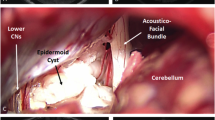Abstract
Background
Meningiomas of the cerebellopontine angle (CPA), although homogenous in terms of location, present different surgical challenges depending on their site of dural origin and extension. Complete tumor resection sometimes leads to high morbidity. The objective of this work is to evaluate the results of surgery and the place of additional treatments.
Methods
In a series of 115 patients with CPA meningiomas, we retrospectively studied 69 patients operated on between 1994 and 2007 using a retrosigmoid approach. Clinical presentation, operative findings and functional outcome were reviewed for a mean follow-up time of 36 months.
Results
Usual presentation was hearing loss associated with gait disturbance (50%) and vertigo (35%). Preoperative cochlear evaluation was abnormal in 40% of the cases. Most tumors (90%) originated on the posterior face of the petrous part of the temporal bone. In one-third of the cases, the meningioma had invaded the internal acoustic meatus. Total or subtotal tumor removal was achieved in 91% of patients without perioperative mortality. Fourteen patients received additional treatment with radiotherapy or radiosurgery for a small residual tumor, often deliberately left in place to reduce operative morbidity. At long-term follow-up, facial nerve function was preserved in 91% of the cases. Hearing worsened in 17% of patients. The tumor recurred in only one case.
Conclusion
The retrosigmoid approach is a safe surgical procedure. The modern management of CPA meningiomas should achieve as complete a resection as possible within reasonable limits, considering that a small residual tumor can be controlled fairly easily with radiosurgery for a relatively long time.





Similar content being viewed by others
References
Bassiouni H, Hunold A, Asgari S, Stolke D (2004) Meningiomas of the posterior petrous bone: functional outcome after microsurgery. J Neurosurg 100:1014–1024
Cushing H (1917) Tumors of the nervous acousticus and the syndrome of the cerebellopontine angle. Saunders, Philadelphia
Kinney SE, Hughes GB, Little JR (1992) Retrolabyrinthine transtentorial approach to lesions of the anterior cerebellopontine angle. Am J Otol 13:426–430
Kleihues P, Burger P-C, Schelthauer B-W (1993) World Health Organization international classification of tumours. Histological typing of tumours of the central venous system, Springer-Verlag Berlin
Mallucci CL, Ward V, Carney AS, O'Donoghue GM, Robertson I (1999) Clinical features and outcomes in patients with non-acoustic cerebellopontine angle tumours. J Neurol Neurosurg Psychiatry 66:768–771
Martuza RL, Parker SW, Nadol JB Jr, Davis KR, Ojemann RG (1985) Diagnosis of cerebellopontine angle tumors. Clin Neurosurg 32:177–213
Nakamura M, Roser F, Dormiani M, Matthies C, Vorkapic P, Samii M (2005) Facial and cochlear nerve function after surgery of cerebellopontine angle meningiomas. Neurosurgery 57:77–90, discussion 77–90
Roche PH, Pellet W, Fuentes S, Thomassin JM, Regis J (2003) Gamma knife radiosurgical management of petroclival meningiomas results and indications. Acta Neurochir (Wien) 145:883–888, discussion 888
Roche PH, Regis J (2005) Cerebellopontine angle meningiomas. J Neurosurg 103:935–937, author reply 937–938
Roser F, Nakamura M, Dormiani M, Matthies C, Vorkapic P, Samii M (2005) Meningiomas of the cerebellopontine angle with extension into the internal auditory canal. J Neurosurg 102:17–23
Schaller B, Heilbronner R, Pfaltz CR, Probst RR, Gratzl O (1995) Preoperative and postoperative auditory and facial nerve function in cerebellopontine angle meningiomas. Otolaryngol Head Neck Surg 112:228–234
Sekhar LN, Jannetta PJ (1984) Cerebellopontine angle meningiomas. Microsurgical excision and follow-up results. J Neurosurg 60:500–505
Silverstein H, Nichols ML, Rosenberg S, Hoffer M, Norrell H (1995) Combined retrolabyrinthine-retrosigmoid approach for improved exposure of the posterior fossa without cerebellar retraction. Skull Base Surg 5:177–180
Thedinger BA, Glasscock ME 3rd, Cueva RA (1992) Transcochlear transtentorial approach for removal of large cerebellopontine angle meningiomas. Am J Otol 13:408–415
Voss NF, Vrionis FD, Heilman CB, Robertson JH (2000) Meningiomas of the cerebellopontine angle. Surg Neurol 53:446, discussion 446–437
Acknowledgment
The authors thank S. Rasika, Ph.D., for her assistance with English.
Conflicts of interest
None.
Author information
Authors and Affiliations
Corresponding author
Additional information
Comment
The colleagues at the Lille University Hospital treated 115 cerebellopontine angle (CPA) meningiomas between 1994 and 2007 – preferring the retrosigmoid approach – as follows:
* 69 using the retrosigmoid approach.
* 20 using trans-labyrinthine, middle fossa, sub-occipital, or combined approaches mainly for meningiomas with a large anterior extension in patients with preoperative deafness.
* 22 with radiosurgery only.
* 4 very old patients with shunt only for hydrocephalus associated with a large meningioma.
Here they retrospectively analyze the 69 CPA meningiomas operated on through the retrosigmoid approach by their NS + ENT team. They honestly and in detail report the spectrum of postoperative problems, the role of radiosurgery in small remnants wisely left behind, and end with a no nonsense Discussion. This article is very recommendable reading – because it can be endlessly discussed for this and this and this detail.
The bottom line is that the days of extensive half-a-day bone drilling approaches to the CPA angle and the clival region are virtually over – except in the most experienced hands – because of high rates of complications, permanent cranial nerve and other neural deficits. And the good old humble retrosigmoid approach – supplemented with single session or fractionated stereotactic radiotherapy when needed – usually suffice in population based neurosurgical practices.
Juha E Jääskeläinen
Kuopio, Finland
Rights and permissions
About this article
Cite this article
Baroncini, M., Thines, L., Reyns, N. et al. Retrosigmoid approach for meningiomas of the cerebellopontine angle: results of surgery and place of additional treatments. Acta Neurochir 153, 1931–1940 (2011). https://doi.org/10.1007/s00701-011-1090-6
Received:
Accepted:
Published:
Issue Date:
DOI: https://doi.org/10.1007/s00701-011-1090-6




